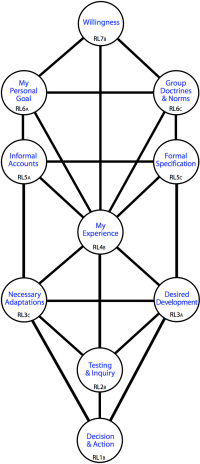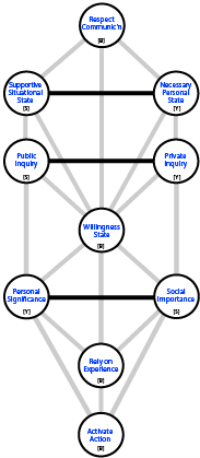Emergent Channels
Warning: This page has become a historical record. The approach used here provided initial help and orientation, but its value turned out to be limited. The names are now updated irregularly as these are finalized through investigating specific emergent Tree frameworks.![]() More
More

Assumptions & Method
The architectural pattern for Channels in Trees has been demonstrated on many occasions by analysis from first principles. It is therefore assumed that this pattern will apply here.
In a conventional Tree, like the shown at right, the core Centre is which interacts with all other Centres except
In the reordered Tree (lower diagrams), , which is in the Root Hierarchy moves to the central KL4B position. , which is, then moves down to the KL2B position.
Note: See a full comparison of these two Root-Level Trees in the next Topic.
The channels are considered in the following order:
- Transverse channels connecting Centres within a Level i.e. KL3, KL5, KL6.
- Channels that connect with (here in KL4B position)
- Channels that connect with (here in KL2B position)
- Channels in an outer ring bypassing both and .
Transverse Channels
These channels are about ensuring an effective connection between person and situation for elements where a mis-fit will be damaging, perhaps disastrous.

KL6: Change of State
In ordinary endeavour, is much lower (at) and refers to an identifiable target state to be realized by suitable action i.e. it is part of content in endeavour. However, in these emergent frameworks, the is contextual and provides guidance. The necessary change in yourself and the desirable change in the environment/situation cannot be wholly disentangled because you are part of the situation. Some mutuality or give-and-take to ensure tolerance and consistency seems essential.
Suggested Channel Name: Reciprocity
KL5: Inquiry
Understanding that focuses on criteria and concerns, regardless of what others might think, should respond to and shape —and vice versa. It is contextual because the Centres are about developing understanding in the situation, rather than getting information to shape an action. For guidance to be effective, understandings emerging from each Centre should complement and generate a fit with the other.
Suggested Channel Name: Complementarity
KL3: Purpose
It is never possible to make progress if socially significant or situation-based are ignored. However, the special effort must spring from you and you cannot succeed if you neglect your own . In identifying what will be given importance in each Centre, some consideration for the other perspective is essential.
Suggested Channel Name: Consideration

Channels To/From Willingness
Under normal circumstances, being willing can be taken for granted because of the goal. Here your degree of willingness is the main concern, and the basis for feeling good about the effort. In its L4B location, the is directly modulated by all other Centres, except for the in the L1Bposition.
Provisional Channel Names
Note: For readability, the reference to specific elements is omitted; and the bi-directional nature of the influence is assumed.
- From KL7: challenges.
- From L6: Your must be enabled so that is sustained by becoming committed. You must also require a that can get support your.
- From L5: Your can ensure that is becoming realistic. However, is needed to ensure gets acceptance socially.
- From L3: should ensure that your becomes credible. Insistence on is, however, essential to get encouraged to remain .
- From L2: allows for energizing and sustaining .

Channels To/From Experience
In endeavour, is in the central KL4B position (see top diagram). In this position, it serves as a way to evaluate what is going on, both in regard to the endeavour's creation (in the upper transcendental levels) and in regard to its practical aspects (in the lower actualization levels).
In the present situation where a transcendent effort is shaping a problematic endeavour, is found in the KL2B position. From here, it interacts more closely with (now at KL4), and it is also closer to relevant (now at KL3). Most significantly, the is now directly linked to the (at KL1B). The function is therefore about directly providing inspiration or instigation or emphasis on a particular form of action.
Provisional Channel Names:
From KL4: can energize
From KL3: must align with , and both require attunement. They also reaffirm your .
From L1: Your can confirm
Channels in the Outer Ring

The upper channels——do not bypass a level in the context part of the framework, but they twice bypass a level in the lower content part i.e. .
Provisional Channel Names
- KL7B and KL6 Centres provide the potential in any Tree. Here focuses the , and releases a demand for . Both are needed to renew the effort.
- The two channels between KL6 and KL5 Centres provide a crucial bridge between that potential and what actually can happen. The and strengthen each other. A channel also joins and because they encourage each other.
- Channels between KL5 and KL3 Centres bypass These ensure that the element deals directly with the . They also enable purely personal and purely situational Centres to interact. So is used to validate your identification of what is . justifies your .
- Channels between KL3 Centres and KL1B bypass and ensure that all are controlled by . channels the , while insisting onconstrains its
- Now compare the emergent Root-Level Tree with the standard .
Last draft: 1-Mar-2014.